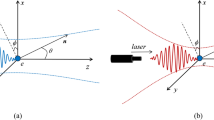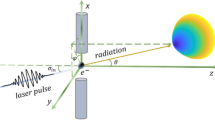Abstract
Based on the Thomson scattering model of a single high-energy electron interacting with a Gaussian laser pulse, the motion of the electron and the spatial radiation characteristics of the scattered light during the process are simulated with the electron’s varying initial position. The results reveal that the initially stationary electron first oscillates, and then travels in a straight line after interacting with a linearly polarized tightly focused intense laser. As the initial position of the electron moves forward on the z axis, the azimuth angle of the maximum energy radiation direction remains unchanged, while the polar angle gradually decreases and finally stabilizes. It is found that the maximum radiated energy in the whole space is obtained only when the electron is initially set at a specific position and when observed from a certain direction. In the maximum energy radiation direction, both the time and the frequency spectra are further studied qualitatively and quantitatively.






Similar content being viewed by others
Data availability
The datasets generated during the current study are available from the corresponding author on reasonable request.
Code availability
Our work is based on MATLAB programming which is in strict obedience to the electrodynamic formulas and theories, codes are available from the corresponding author on reasonable request.
References
Baltuska, A., Udem, T., Uiberacker, M., et al.: Attosecond control of electronic processes by intense light fields. Nature 421, 611–615 (2003)
Chi, Z., Du, Y., Huang, W., et al.: Linearly polarized X-ray fluorescence computed tomography based on a Thomson scattering light source: a Monte Carlo study. J. Synchrotron Radiat. 27, 737–745 (2020)
Corde, S., Ta Phuoc, K., Beck, A., Fitour, R., Malka, V., Rousse, A., Beck, A., Lefebvre, E.: Femtosecond x rays from laser-plasma accelerators. Rev. Mod. Phys. 85, 1–48 (2013)
Corkum, P.B., Burnett, N.H., Ivanov, M.Y.: Subfemtosecond pulses. Opt. Lett. 19, 001870 (1994)
Corkum, P.B., Krausz, F.: Attosecond science. Nat. Phys. 3, 381–387 (2007)
Eidam, T., Handf, S., Seise, E., Andersen, T.V., Gabler, T., Wirth, C., Schreiber, T., Limpert, J., Tünnermann, A.: Femtosecond fiber CPA system emitting 830 W average output power. Opt. Lett. 35, 94–96 (2010)
He, F., Yu, W., Lu, P., et al.: Ponderomotive acceleration of electrons by a tightly focused intense laser beam. Phys. Rev. E 68, 046407 (2003)
Kaplan, A.E., Shkolnikov, P.L.: Subfemtosecond pulses in the multicascade stimulated Raman scattering. J. Opt. Soc. Am. B 13, 347–354 (1996)
Kawano, H., Hirakawa, Y., Imasaka, T.: Generation of high-order rotational lines in hydrogen by four-wave Raman mixing in the femtosecond regime. Quantum Electron IEEE J. 34, 260–268 (1998)
Khrennikov, K., Wenz, J., Buck, A., et al.: Tunable all-optical quasimonochromatic Thomson X-ray source in the nonlinear regime. Phys. Rev. Lett. 114, 195003 (2015)
Krausz, F., Ivanov, M.: Attosecond physics. Rev. Mod. Phys. 81, 163–234 (2009)
Lee, K., Cha, Y.H., Shin, M.S., et al.: Relativistic nonlinear Thomson scattering as attosecond x-ray source. Phys. Rev. E 67, 026502 (2003)
Lee, K., Chung, S.Y., Park, S.H., et al.: Effects of high-order fields of a tightly focused laser pulse on relativistic nonlinear Thomson scattered radiation by a relativistic electron. EPL Europhys. Lett. 89, 613–630 (2010)
Li, J., Hatsagortsyan, K.Z., Galow, B.J., et al.: Attosecond gamma-ray pulses via nonlinear Compton scattering in the radiation-dominated regime. Phys. Rev. Lett. 115, 204801 (2005)
Li, K., Li, L., Shu, Q., et al.: Spatial characteristics of motion and emission from electron driven by linearly polarized tightly focused laser pulses. Optik 183, 813–817 (2019)
Maine, P., Strickland, D., Bado, P., Pessot, M., Mourou, G.: Generation of ultrahigh peak power pulses by chirped pulse amplification. IEEE J. Quantum Electron. 24, 398–403 (1988)
Mikhailova, Y.M., Platonenko, V.T., Rykovanov, S.G.: Generation of an attosecond X-ray pulse in a thin film irradiated by an ultrashort ultrarelativistic laser pulse. J. Exp. Theor. Phys. Lett. 81, 571–574 (2005)
Mourou, G.A., Barry, C.P.J., Perry, M.D.: Ultrahigh-intensity lasers: physics of the extreme on a tabletop. Phys. Today 51, 22–28 (1998)
Perry, M.D., Mourou, G.: Terawatt to petawatt sub-picosecond lasers. Science 264, 917–924 (1994)
Pogorelsky, I.V., Ben-Zvi, I., Hirose, T., et al.: Demonstration of 8×1018 photons/second peaked at 1.8 Å in a relativistic Thomson scattering experiment. Phys. Rev. Accel. Beams 3, 090702 (2000)
Sakai, I., Aoki, T., Dobashi, K., et al.: Production of high brightness γ rays through backscattering of laser photons on high-energy electrons. Phys. Rev. Accel. Beams 6, 091001 (2003)
Ta Phuoc, K., Corde, S., Thaury, C., et al.: All-optical Compton gamma-ray source. Nat. Photonics 6, 308–311 (2012)
Thomlinson, W.: Medical applications of synchrotron radiation. Nucl. Instrum. Methods Phys. Res. Sect. A 319, 295–304 (1992)
Vais, O.E., Bychenkov, V.Y.: Nonlinear Thomson scattering of a tightly focused relativistically intense laser pulse by an ensemble of particles. Quantum Electron. 50, 922–928 (2020)
Wang, Y., Wang, C., Li, K., et al.: Spatial radiation features of Thomson scattering from electron in circularly polarized tightly focused laser beams. Laser Phys. Lett. 18, 015303 (2021)
Yan, W., Fruhling, C., Golovin, G., et al.: High-order multiphoton Thomson scattering. Nat. Photonics 11, 514–520 (2017)
Zhuang, J., Yan, Y., Zhou, X.: Quasi-monochromatic spectral emission characteristics from electron collision with tightly focused laser pulses. Laser Phys. 31, 035401 (2021)
Acknowledgements
This work has been supported by the National Natural Science Foundation of China under Grant No. 10947170/A05, Natual science fund for colleges and universities in Jiangsu Province under Grant No. 10KJB140006, and Foundation of NJUPT under Grant No. NY2015154, and sponsored by Jiangsu Qing Lan Project.
Funding
This work has been supported by the National Natural Science Foundation of China under Grant No. 10947170/A05, Natual science fund for colleges and universities in Jiangsu Province under Grant No. 10KJB140006, and Foundation of NJUPT under Grant No. NY2015154, and sponsored by Jiangsu Qing Lan Project.
Author information
Authors and Affiliations
Contributions
All authors made contributions to the study conception and design. Analysis, programming and the first draft of the manuscript were performed by YY; XZ collected and summarized the results, and provided detailed suggestions on revision; and YT offered overall guidance as well as corrected possible errors which may lead to misunderstanding. All authors commented on previous versions of the manuscript. All authors read and approved the final manuscript. Figures 2–6 are all generated through MATLAB.
Corresponding authors
Ethics declarations
Conflict of interest
The authors declare that they have no conflict of interest.
Additional information
Publisher's Note
Springer Nature remains neutral with regard to jurisdictional claims in published maps and institutional affiliations.
Rights and permissions
Springer Nature or its licensor holds exclusive rights to this article under a publishing agreement with the author(s) or other rightsholder(s); author self-archiving of the accepted manuscript version of this article is solely governed by the terms of such publishing agreement and applicable law.
About this article
Cite this article
Yan, Y., Zhou, X. & Tian, Y. Influence of high-energy electron’s initial position on its spatial radiation characteristics during interaction with a linearly polarized tightly focused laser. Opt Quant Electron 54, 865 (2022). https://doi.org/10.1007/s11082-022-04162-0
Received:
Accepted:
Published:
DOI: https://doi.org/10.1007/s11082-022-04162-0




